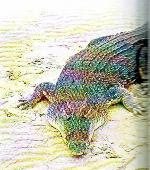Dactylogyriasis (Worms Gills)
Dactylogyriasis (Worms Gills) Cause: Dactylogyrus spp., Cychlidogyrus spp., Quadricanthus spp. Bio-Ecology Pathogens • Ekto-obligate parasites that are parasitic and reproduce by laying eggs • infect all species of freshwater fish, especially the size of the seed. Transmission occurs when infective face (Onchomiracidium). • Dactylogyrus spp. has 2 pairs of eye point, and at the tip of his head there are 4 bumps. Cychlidogyrus spp. shape is more flattened at both ends, and only has a pair of eye point. Quadricanthus spp. shape Dactylogyrus similar spp., and has a host of species that target specific groups of catfish. • Severe infections can kill 30-100% within a few weeks Clinical Symptoms: • pale body color, decreased appetite, thin, nervous and slow • Respiratory frequency increased, the production of excess mucus in the gills and often cavort • Gather / closer to the water inlet • Gills pale or swollen so that the open operculum Diagnosis: • Visual observation of behavior and clinic...


